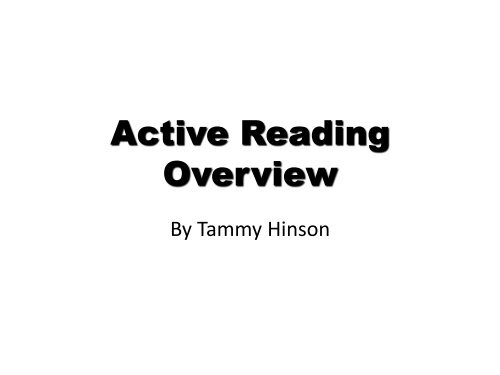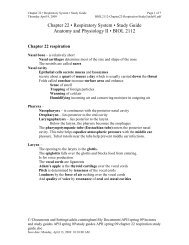Active Reading Presentation
Active Reading Presentation
Active Reading Presentation
Create successful ePaper yourself
Turn your PDF publications into a flip-book with our unique Google optimized e-Paper software.
<strong>Active</strong> <strong>Reading</strong><br />
Overview<br />
By Tammy Hinson
What is active reading?<br />
• A strategy that gets reader involved with material.<br />
– Helps reader understand the author’s opinion about the topic of the<br />
reading selection.<br />
– Helps reader form judgments about material that is read.<br />
– Best suited for reading that emphasizes the author’s concepts and<br />
opinions based on facts gathered through research and observation.<br />
• Short stories<br />
• Novels<br />
• Magazine articles<br />
• Editorials or opinion pieces<br />
• Process that develops critical thinking skills<br />
– Analysis<br />
– Synthesis<br />
– Evaluation
<strong>Active</strong> reading questions<br />
• <strong>Active</strong> readers must answer eight questions.<br />
– What is the author’s main idea?<br />
– What main points support the main idea?<br />
– Is the support adequate and convincing?<br />
– Is the author expressing facts, opinions or both?<br />
– What is the author’s tone/attitude?<br />
– What is the author’s purpose?<br />
– Who is the author’s intended audience?<br />
– What is the source of the author’s detail?
<strong>Active</strong> reading questions<br />
• What is the author’s main idea?<br />
– What is the topic of the article?<br />
– What is the author’s opinion of that topic?<br />
• What main points support the main idea?<br />
– What reasons or examples does the author give<br />
that help to explain his/her opinion about the<br />
topic.
<strong>Active</strong> reading questions<br />
• Is the support adequate and<br />
convincing?<br />
– Does the author give reasons that make<br />
sense?<br />
– Does the author give more than one<br />
reason?<br />
• Is the author expressing facts, opinions<br />
or both?<br />
– Facts are exact details.<br />
– Facts are specific information.<br />
– Facts can be proven to be true.
<strong>Active</strong> reading questions<br />
• What is the author’s purpose?<br />
– To share?<br />
– To inform?<br />
– To entertain?<br />
– To persuade<br />
• Who is the author’s intended audience?<br />
– Is the author writing to the general public?<br />
– Is the author writing to a special audience?<br />
• What is the source of the author’s detail?<br />
– Observation<br />
– Personal experience?<br />
– Research?<br />
– Reasoning?
<strong>Active</strong> reading questions<br />
• What is the author’s tone/attitude?<br />
– Serious?<br />
– Sarcastic?<br />
– Preachy?<br />
– Humorous?<br />
– Angry<br />
– Insulting?
Answering active reader questions<br />
• Always complete four steps to find the<br />
answers to the eight active reader<br />
questions.<br />
– Surveying<br />
– Uninterrupted reading<br />
– Studied reading<br />
– Review
First step of active reading<br />
• Surveying<br />
– Check the title<br />
• What does title tell you about what you will be<br />
reading?<br />
• Who is the author?<br />
• Has instructor said anything about the author?<br />
– Look through the material<br />
• Headings<br />
• Boldface type<br />
• Italics<br />
• Lists
First step of active reading<br />
• Surveying<br />
– Read the opening and closing paragraphs.<br />
• What clues do these provide about content and<br />
writer’s purpose?<br />
– Read first sentence of each paragraph.<br />
• What clues these provide about the content?<br />
– Once readers have surveyed material they will<br />
have a sense of what to expect when the<br />
material is read in detail.
Second step of active reading<br />
• Uninterrupted reading<br />
– Read material quickly, but attentively without<br />
stopping.<br />
• Circle words in the passage you don’t understand to<br />
check later.<br />
• Place question mark next to material you don’t<br />
understand.<br />
– Keep going<br />
• Try to determine the writer’s main point.<br />
– After completing this step, write as many<br />
answers to active reader questions that you can.<br />
• Look up every word that you have circled and write<br />
meaning in the margin near the circled word.<br />
– Take a short break, if you feel you need one.
Third step of active reading<br />
• Studied reading<br />
– Underline author’s thesis (main point) if it is<br />
stated.<br />
• Identify the sentences that express the author’s<br />
opinion about the topic.<br />
– Also underline the main points that support the<br />
thesis.<br />
• Identify the sentences that explain the reason for the<br />
author’s opinion.<br />
– As you read, record your observations<br />
• Personal comments<br />
• Note your agreement or disagreement<br />
– After this reading, answer remaining active<br />
reader questions.
Fourth step of active reading<br />
• Review<br />
– Close your book and try to answer each of the<br />
eight active reader questions.<br />
– Answers to these questions form a summary of<br />
the material you just read.<br />
– Or recite the answers to active reader questions<br />
to another person.<br />
• Following this reading strategy should help<br />
you to understand most author’s concepts<br />
and opinions.
















